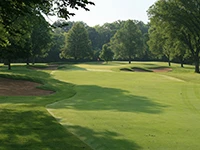
Being cautious and implementing preventive measure against anthracnose is less of a headache than trying to get rid of it, according to Dan Dinelli, superintendent at North Shore Country Club in Glenview, Ill.
And based on personal experience fighting the turf disease, Dinelli recognizes what precautions to take and how to keep resistance at bay.
“Problem areas relate to poor drainage, sunlight and air movement,” says Dinelli. “So, try to do the best you can to keep proper, even and balanced soil moisture and nutrients by spoon-feeding your turf.”
Evaluating the course’s weaknesses based on those three problem areas could save a lot of hassle, he says. It helps relieve stress on the turf, thus decreasing the likelihood of anthracnose, which thrives when turf is under stress.
"A high percent of Poa grass is more susceptible to anthracnose, more so than bentgrass, so you use a fungicide to decrease the likelihood of anthracnose. It’s a disease you want to prevent because to treat anthracnose can be difficult.”
To further prevent anthracnose from infecting turf Dinelli has a few suggestions. "You do what you can to ensure overall plant health," Dinelli says. "Proper nutrition, mowing habits and water management are the best ways to prevent anthracnose." A consistent maintenance schedule goes a long way to alleviate stress during the season.
Dinelli uses a combination of fungicides to avoid anthracnose from creeping in on his turf, and he continues to test out new combinations and approaches on anthracnose nursery patches throughout the course. Keeping tests running through the season gives him the ability to see what he’s doing right and what’s less effective, he says. “On greens in the summer I use Signature Chipco and in the spring I use Tartan. On fairways I use Mirage and Civitas,” he says.
Fungicides play a major role in his fight against anthracnose, but he uses them as a tool alongside his maintenance practices. Dinelli’s rotation of chemicals is key when preventing anthracnose resistance.
“With anthracnose there is an issue called resistance. The pathogens can become resistant to some of the different fungicide chemicals,” says Dinelli. “You have to assure you have a good rotation of chemicals. Sometimes anthracnose will have different resistance to the different treatments. You have to be aware of it.”
The key elements to fighting anthracnose that Dinelli stresses are to have rotating fungicides and to maintain your turf's health. Dinelli says, “Anthracnose takes over the stress of a plant,” so when his turf is under less stress, he is as well.
Latest from Golf Course Industry
- Carolinas GCSA raises nearly $300,000 for research
- Advanced Turf Solutions’ Scott Lund expands role
- South Carolina’s Tidewater Golf Club completes renovation project
- SePRO to host webinar on plant growth regulators
- Turfco introduces riding applicator
- From the publisher’s pen: The golf guilt trip
- Bob Farren lands Carolinas GCSA highest honor
- Architect Brian Curley breaks ground on new First Tee venue






